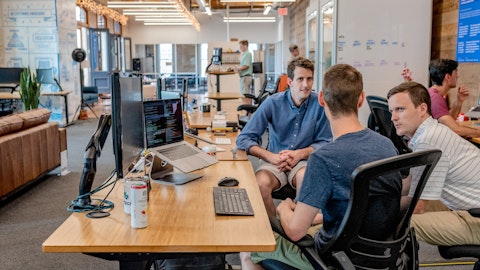Antonio Pietri: Hi, Jason.
Jason Celino: Thanks. Hi, Antonio. Hi, Chantelle. One question on the unbundling or the separability for OSI. The price that customers pay is it — is there any difference between when it gets separated or is it net equal from the total perspective?
Chantelle Breithaupt: Yeah. Well, I think probably more to come in the sense of what’s possible. I would say just the apples-to-apples answer, Jason, it’s a separation of the pieces. Once it goes to third-party services that will be their conversation to have. But I would expect apples-to-apples to be fairly similar with opportunities there as we work through to demonstrate our value to see where we can take that to.
Jason Celino: Okay. Excellent. And then maybe just building off of or following up with Rob’s guidance question. Can you just remind everyone what type of macro or business conditions were you kind of baking into the book ends of the range?
Antonio Pietri: Yeah. Well, I think at the high end, in a way is what we talked about, the good budget, solid budgets into 2023. Macroeconomic conditions that support the industries that we’re in. Certainly, the continued investment in expansion and upgrade of grid into utilities and more CapEx spend in upstream and midstream. That operate also supports solid chemicals spending. The low end, think about it, the opposite on the macro environment and budget, but also throwing avid, throwing regional conflicts in Europe, so those are the bookends for those two. We see China reopening from COVID and while the conflict in Europe is created certainly difficult dynamics for chemical customers. We continue to see good business from customers in Europe in refining and EPCs. The EPC industry in general around the world is on the up and up because it’s a global business or what they might be headquartered in Europe, they are doing global projects.
So — but those are the factors. And 10.5 is worst case scenario, 13.5 is a great outlook.
Jason Celino: Okay. Great. That was super helpful. Thank you.
Operator: Thank you. And I show our next question comes from the line of Mark Schappel from Loop Capital. Please go ahead.
Mark Schappel: Hi, Antonio. Hi, Chantelle. Antonio, starting with you, in your prepared remarks, you mentioned some of the Emerson Aspen integration sales efforts and milestones. I was wondering if you could just speak to any early efforts with Emerson to sell your products into other markets that Aspen historically hasn’t played in such as pulp and paper and in wastewater?
Antonio Pietri: Yes. Well, let me look at those efforts are ongoing. Of course, both Emerson and AspenTech had great familiarity with our core markets and there’s big capital projects happening in oil and gas, chemicals, even in refining in the Middle East and Asia. So it’s natural that some of the first wins you would see are in those four industries. At the same time, as you said, Emerson has the presence in other industries. We’re enabling the sales people and teams in those industries. We’re also working to determine the value proposition for some of these industries and some of the applications. And I would argue that’s a longer term tail to business generation. But nonetheless, it’s an ongoing effort, and it’s part of our targeted initiatives especially with pharma, while AspenTech is been in pharma. Emerson has a first or second largest market share in that area and we see great opportunities for both companies with Emerson’s leadership in that space.
Mark Schappel: Okay. Great. Thank you. That’s all from me.
Operator: Thank you. And I show our next question comes from the line of Dustin (ph) Moskovitz from Wolfe Research. Please go ahead.
Unidentified Participant: Hi, Antonio. This is on for Gal. Thanks for taking the question. So with suite for Linux go on development. I was wondering whether when that comes when it becomes complete, whether there will be any incremental benefit from this because Linux operating systems generally tend to be used with larger corporations because of better safety and greater security parameters. Relative to Windows, which you guys released in fiscal Q1 and whether that could continue to drive large deals in SSE correspondingly strong contribution to ACV growth in the year. Thank you. And just one follow-up after that.
Antonio Pietri: Yes. No, Arsenio (ph), no doubt. What we’ve learned is that the leanest version of the operating — our operating system is more common with higher workload applications, more sophisticated applications in the SSE suite. Perhaps applications that consume a lot more tokens as well, that suite will be released soon. And we do expect to sort of capture that incremental use. But the bulk of the SSE suite usage is with the Microsoft operating system. I do want to emphasize that.
Unidentified Participant: Got it. And then just to follow up on the guidance question. What has to happen, I guess, to improve relative to today to get towards that top end range of guidance? Is there any call-outs in particular sectors that you would need to see perform better than what you currently seen in the first half of fiscal ’23? Thank you.
Antonio Pietri: Well, I mean, look, the reason we maintained 13.5% at the high end of our guidance is because we have visibility, we’ll have a path into that number. And with that, the pipeline of business and supported by synergies and then benefits from the transformation of OSI and SSC. So what needs to happen. Look, it’s execution and not being impacted by some of the things that I’ve mentioned, COVID and conflict in Europe, so prices around transformation, the transformation of a business is not linear per se. There’s always surprises in and you can always be tripped in your execution. We found some things in the last six months that were not in our assumptions, but we’ve been able to overcome them and we don’t know of anything that could trip us in the second half of the year, but we also want to be cautious because there’s a lot of we’re lifting a lot of rocks and assuming that we’re going to find what we think we’re going to find and in some cases, we may not.
So we’re just being cautious about that. But if we continue to execute on the transformation that we did in the first half, then that path to 13.5% is there.
Unidentified Participant: Great. Thank you very much.





